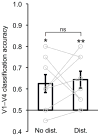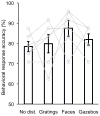Decoding the content of visual short-term memory under distraction in occipital and parietal areas
- PMID: 26595654
- PMCID: PMC4696876
- DOI: 10.1038/nn.4174
Decoding the content of visual short-term memory under distraction in occipital and parietal areas
Abstract
Recent studies have provided conflicting accounts regarding where in the human brain visual short-term memory (VSTM) content is stored, with strong univariate fMRI responses being reported in superior intraparietal sulcus (IPS), but robust multivariate decoding being reported in occipital cortex. Given the continuous influx of information in everyday vision, VSTM storage under distraction is often required. We found that neither distractor presence nor predictability during the memory delay affected behavioral performance. Similarly, superior IPS exhibited consistent decoding of VSTM content across all distractor manipulations and had multivariate responses that closely tracked behavioral VSTM performance. However, occipital decoding of VSTM content was substantially modulated by distractor presence and predictability. Furthermore, we found no effect of target-distractor similarity on VSTM behavioral performance, further challenging the role of sensory regions in VSTM storage. Overall, consistent with previous univariate findings, our results indicate that superior IPS, but not occipital cortex, has a central role in VSTM storage.
Conflict of interest statement
The authors have no competing financial interests.
Figures







Comment in
-
How Do Visual and Parietal Cortex Contribute to Visual Short-Term Memory?eNeuro. 2016 May 3;3(2):ENEURO.0041-16.2016. doi: 10.1523/ENEURO.0041-16.2016. eCollection 2016 Mar-Apr. eNeuro. 2016. PMID: 27294194 Free PMC article. No abstract available.
References
-
- Todd JJ, Marois R. Capacity limit of visual short-term memory in human posterior parietal cortex. Nature. 2004;428:751–754. - PubMed
-
- Xu Y. Distinctive neural mechanisms supporting visual object individuation and identification. Journal of Cognitive Neuroscience. 2009;21:511–518. - PubMed
-
- Xu Y, Chun MM. Dissociable neural mechanisms supporting visual short-term memory for objects. Nature. 2006;440:91–95. - PubMed
Publication types
MeSH terms
Grants and funding
LinkOut - more resources
Full Text Sources
Other Literature Sources
Molecular Biology Databases

